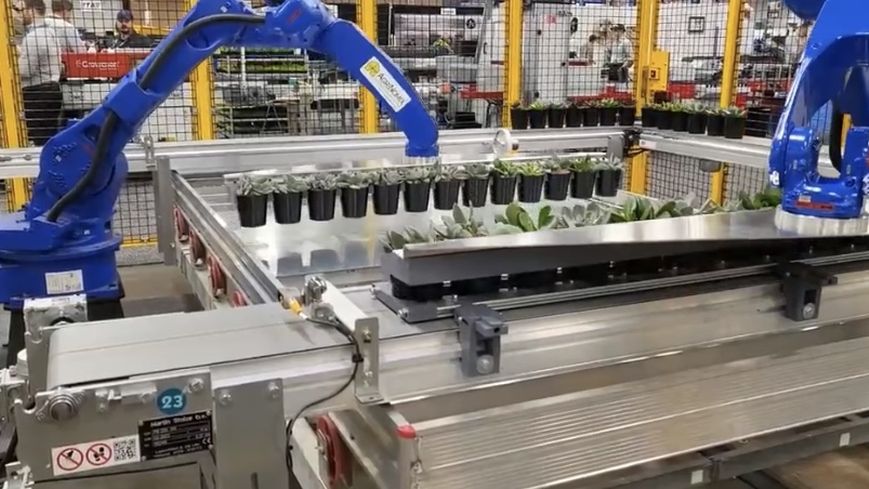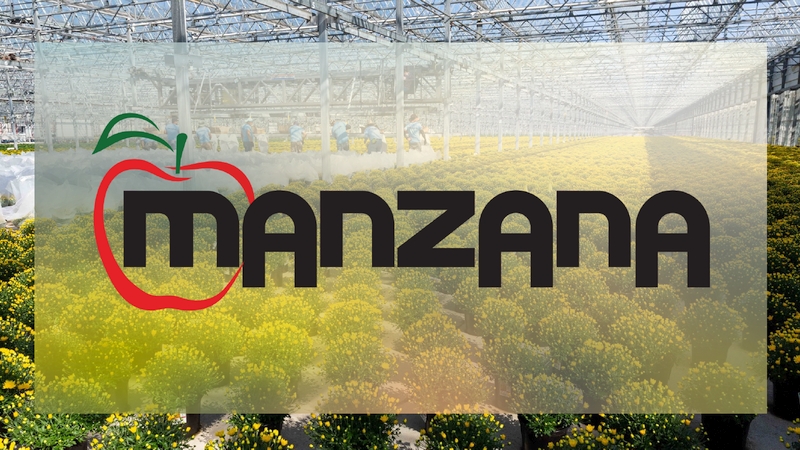How Labor Challenges Spur Greenhouse Technology Innovations

Above is a Robotic Work Cell that can be customized based on application requirements. In this example, it is transporting potted plants. Photo: AdeptAg
Every grower in the horticulture industry is struggling with their workforce. It is becoming more difficult to recruit and retain qualified employees, especially when the tasks often require manual labor and repetitive tasks. The struggle, however, is leading to innovation.
As growers continue their operations with less workers, technology plays a major role. Automated systems can complete some tasks better than humans, says Allison Kopf, Chief Growth Officer for IUNU. She also sees more greenhouse acreage built than ever before, requiring growers to do more with less.
“We’ve been reaching a pressure point on labor for the past few years,” Kopf says. “With labor shortages deepening and the need for experienced growers rising, technology has a critical role to play.”
Automation Saves on Labor
Kopf says technology enables humans to automate and augment processes. Technology could be used to automate labor-intensive practices. It can also augment growers, she says, so they can manage more acreage, grow higher quality crops, and produce more profit. Humans are better than computers at many tasks, but computers have the edge on a few specific tasks, such as counting.
“Counting is a repetitive, low skill process, but also requires high attention to detail,” Kopf says. “These types of processes are consistently inconsistent. If you send 10 people out to count inventory, we all know you’ll see 10 different inventory counts.”
Automating a process like counting cuts down on labor and increases the accuracy of the data, Kopf says. Technology also works well for tasks such as scouting, grading, forecasting, and counting germination rates.
She says technology provides linear or geometric value. Machines, such as harvesting or transplanting machines, offer linear value because they replace human labor and will always have the same return on investment (ROI). Automated counting processes have geometric value. Kopf says the system automates the process, but also augments it and learns over time.

IUNU’s LUNA AI monitors plants in a greenhouse and provides data for crop steering. Photo: IUNU
“Artificial intelligence continues to have increased ROI,” she says.
Some growers have embraced technology and find it beneficial for their operation, while others are hesitant to test out automated systems. Kopf says growers can start by looking for processes that are labor-intensive and repetitive.
Dr. Erik Runkle, Professor and Floriculture Extension Specialist at Michigan State University, says increasing production efficiency means decreasing input costs on a per crop basis and increasing sell-through. Labor and energy are two of the greatest input costs, so growers are advised to look for ways to streamline production.
“The answer is usually situational to the grower, but many labor-intensive tasks (such as transplanting, pinching, and watering) can be partly or completely automated,” Runkle says. “With the inadequate supply of labor in many locations as well as increasing labor costs, investing in automation equipment can be more economical today than it was even a few years ago.”
Efficiency Gains Through LED Lighting
Runkle says lighting companies continue to develop more efficient LED fixtures. However, efficiency gains from one year to the next are now happening at a slower rate. Growers who are waiting to replace old high-pressure sodium fixtures should not wait any longer, he says.
“The combination of efficiency gains, longer lifetimes, and in many cases rebates and incentives from utility companies, can make for a relatively short return on investment,” Runkle says.
LEDs are still a relatively new lighting technology for greenhouse applications, he says, but they have become more reliable and fixture failures are less common, based on feedback from growers. There are many different LED fixtures and lighting companies on the market, so the biggest challenge is choosing which one to buy.
“When choosing an LED fixture for your greenhouse, carefully evaluate the effects of the light spectrum on plant growth, energy efficiency, and visual quality,” Runkle says. “The most efficient fixtures usually emit a purple-ish light, which can be unpleasant for workers. The intensity and spectrum, particularly for blue light, can also influence crop compactness. There isn’t a ‘one size fits all’ lighting solution. Rather, it will be situational depending on the greenhouse, crop, and grower.”
Supplemental lighting has the greatest benefit at night and on cloudy days, he says. Runkle advises growers to have the lights turn off automatically when it is sunny because the benefit of more light is greatly diminished.
Runkle adds that higher fuel prices make it important to provide a growing environment that minimizes time in the greenhouse without sacrificing crop quality. Lowering the greenhouse temperature to save on energy costs can actually increase the cost on a per-crop basis. He says that crop time increases as the temperature decreases, so the plants need to be heated for a longer period.
In addition to considering new technologies, Runkle says to think about maintaining or improving technology you already have. For example, automated energy or shade curtains are not new, but they can decrease greenhouse heat loss overnight. They must be maintained to achieve the greatest energy savings.
Automation Enhances Jobs for Greenhouse Workers
People are key to a successful business, according to Kris Nightengale, Vice President of Sales for AdeptAg. People must be in a position that helps them succeed, which includes enjoying their daily tasks and showing advancement in their careers. With a limited labor pool, there are some tasks that automated systems can do better, freeing up workers for tasks that use their brains, not their backs.
Laborers do not want to work in direct sunlight for hours or work in an uncomfortable position. Automating some of these labor-intensive tasks creates a safer working environment for the employees.
Nightengale says soil mixing, seeding, and transplanting can be replaced with automated systems, in addition to watering with booms. When machines mix soil, the growing media is more consistent. Seeding is an arduous task when done by hand. Machines can complete this task faster and with better accuracy than humans.
“Where we see investment taking place first is where we get a crop benefit and a human benefit, where the human has to work less and accomplish much more,” Nightengale says.










